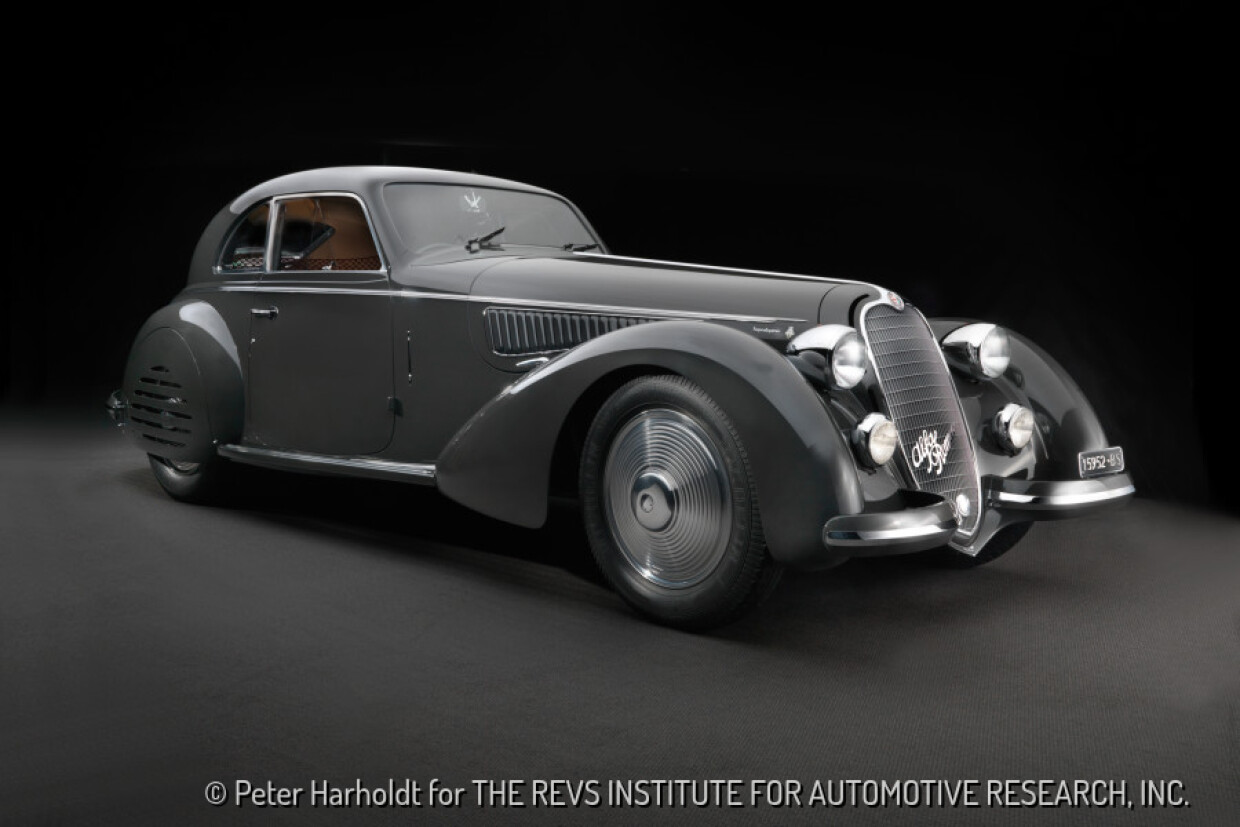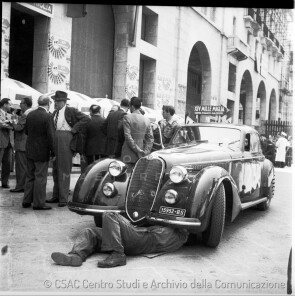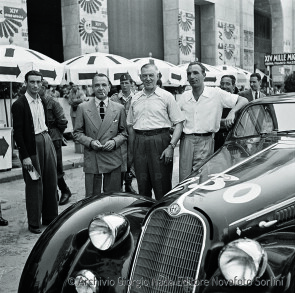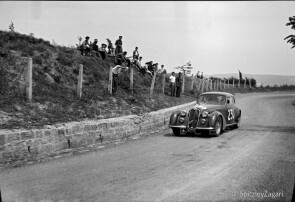
1938 Alfa Romeo 8C 2900 B
ON/OFF
Why am I an Automotive Masterpiece?
K. Famous chassis’ cars
The last Berlinetta long chassis bodyworked by Carrozzeria Touring
L. Limited edition cars
no. 5 manufactured
The Alfa Romeo 8C family represented the pinnacle of technological achievement reached by the "Casa del Portello" in the 1930s. Designed in 1930 by Vittorio Jano, they were produced from 1931 to 1938 in various versions, both for the road and competition, named according to their displacement and body type. High performance, excellent road handling, and reliability placed the 8C among the best cars of their era. According to Jano, a car designed for racing should not only be powerful but also stable, maneuverable, and as lightweight as possible to adapt to road use. The 8C elevated this principle to the maximum, evident in the results achieved in both road and track races. Jano designed the engine, leveraging experience gained from the P2 on the tracks and the 6C series on the roads. Exceptional qualities of power, elasticity, and robustness ensured competitiveness and longevity. Jano opted for an inline 8-cylinder twin-cam aluminum engine, supercharged with a volumetric compressor, starting at 2336 cc. The internal cylinder measurements were identical to those of the 6C 1750, along with other internal details, to control costs. The final displacement increased subsequently to 2600 cc and then up to 2900 cc. To avoid torsion problems due to the length of the inline 8-cylinder crankshaft, Jano chose the split-block solution. This allowed him to divide the engine in half, into two blocks of four cylinders with the distribution in the center. Dry sump lubrication was employed. The two aluminum alloy cylinder heads followed the design of the 6C engine. The obtained power was 142 hp at 5000 rpm, a very high figure for the time and especially usable thanks to the flexibility provided by the compressor. The chassis, with longitudinal and cross members, was available in three different lengths: "Lungo" (3100 mm) for endurance races, "Corto" (2750 mm) for road races, and "Monza" (2650 mm) for circuit races. The suspension system featured a live axle with semi-elliptical leaf springs. The drum brakes, finned, were rod operated. Subsequently, on the 8C 2900, independent four-wheel suspensions were introduced, and the brakes adopted hydraulic control. The steering was on the right, as was customary in the 1930s. The first version, 8C 2300, was produced between 1931 and 1935 in 188 or 189 units, becoming the car to beat in any competition and sought after by the best drivers and wealthy gentlemen drivers. Celebrated coachbuilders began to clothe the naked chassis. The only real "flaw" was the high price. The exceptional results of this car in racing provided the pretext in 1933 for Alfa Romeo to withdraw from racing, having demonstrated its unbeatable prowess. In reality, the reason was economic: the production of the 8C and sporting activities were costly, and the Milanese company struggled to generate sufficient profits. Still, the IRI (Istituto di Ricostruzione Industriale), supported by Mussolini, represented the salvation of the company. The name Alfa Romeo was kept high in racing by Scuderia Ferrari.
The Alfa Romeo 8C 2900 is celebrated for its exceptional qualities and is among the contenders for the best prewar classic car. Much has been written about it in articles and books. It is praised for its great versatility, encompassing both racing and "gran turismo"; the "two-nine" encapsulated all the qualities of Alfa Romeo. At the 1935 Paris Salon, Alfa Romeo unveiled a new Sports category model: the 8C 2900 A. Jano designed it by incorporating engines and components from the Tipo B P3. These engines were paired with the new chassis of the Tipo C, featuring independent suspensions on all wheels, a "transaxle" gearbox, and hydraulic drum brakes. Six units were produced, with five chassis featuring the "Botticella" body inspired by the Tipo C. The first unit, with a production Alfa Romeo Spider Corsa body, was so admired that it was showcased again in Paris and London in 1937, two years after its launch. The debut at the 1936 Mille Miglia was a triple success, with three 8C 2900 A "Botticella" from Scuderia Ferrari securing the top three positions. The winner, Antonio Brivio, shortened the time of the previous year's winner by an hour and a quarter. The success was repeated at the Mille Miglia 1937 with a one-two finish, and Pintacuda in 1938 maintained an average speed of about 177 kph from Brescia to Bologna on regular roads. To capitalize on the prestige gained in competitions by the 8C 2900 A, Alfa Romeo chose to create a luxurious and elegant version for sports touring. The 8C 2900 B Corto and Lungo, with two variants of the chassis length, amazed with technological refinement and the beauty of the bodies, crafted by Touring and Pinin Farina, among others. The starting point was the chassis of the "domesticated" 8C 2900 A for road use. The chassis was lengthened and strengthened. The engine power was reduced to 180 hp, but the rest was borrowed entirely from the 8C 2900 A. The 8C 2900 B was available in two versions, "Corto" and "Lungo," distinguished by the wheelbase length of 2800 and 3000 mm, respectively. Carrozzeria Touring created a series of berlinettas and cabriolets with a sinuous and elegant line, both on "Corto" and "Lungo" chassis, characterized by a sloping tail, compact cockpit, long hood, and inclined grille. The wheels were often streamlined, following the latest advancements in aerodynamics, and using the patented "Superleggera" method. Pinin Farina also created two 8C 2900 B chassis, producing two spiders, the second of which already had retractable headlights. Zagato and Stabilimenti Farina each produced a chassis, the former being very sporty and the latter very luxurious. The last success of the 8C 2900 B, confirming its highly advanced technical qualities, came at the 1947 Mille Miglia, the first post-war edition, where the 8C 2900 B Lungo Berlinetta Touring, driven by Clemente Biondetti, emerged victorious, despite being depowered by removing the compressors, in accordance with the new technical regulations.
Five examples of the Alfa Romeo 8C 2900 B were coachbuilt by Touring in the berlinetta version, specifically chassis numbers 412020, 412024, 412029, 412035, and 412036. Assembled using the Superleggera method, this model shared the basic design adopted for the 6C 2300 B Mille Miglia, gaining extraordinary grandeur due to the longer chassis of the 8C. The chassis number 412036 is the last of the 5 berlinetta examples with Touring body number 2033. Originally equipped with two spotlights under the headlights, spats on the rear wheels, and lacking the large wheel covers on the front wheels, which would appear later (never used in races). It had turn indicators in front of the doors and the Touring badge on the hood. Many of the long-wheelbase models were produced in 1938, including chassis number 412036, which was exhibited at the Alfa Romeo stand at the Salon de l'Automobile de Paris from October 6 to October 16, 1938. The event was extensively covered by the contemporary press, and the car (as seen in a photo from the Motori Aerei Cicli e Sport magazine) was presented to the French president. The car appears in period images in a dark color, and, according to Giovanni Canestrini's article in L'Auto Italiana on October 30, 1938, it was painted in "Rosso Italico." It was purchased in November 1938 by Milanese Alfredo Rovida and registered. It was resold after only 7 months to the racing driver Angelo Biemmi, who took the precaution of hiding the car on his estate in Iseo during the war, preserving it. In 1947, Emilio Romano, an Alfa Romeo dealer in Brescia, acquired the car to compete in the Mille Miglia. It was the first post-war edition of the race, overcoming the ban on road races in Italy following serious accidents in the disastrous 1938 edition. That year, supercharging was prohibited, so Romano had to remove the two blowers and switch to normal aspiration through four Weber carburetors, increasing the compression ratio. This modification reduced the car's power from 180 to 137 hp. The competition was fierce, with Maserati and Ferrari entering new models, and an exciting debut from Cisitalia, led by Tazio Nuvolari. Romano was "just" a gentleman driver but enlisted Clemente Biondetti, a race veteran, as his co-driver. Although starting 149th out of 153 competitors, they found only one real competitor in Nuvolari. The unyielding fifty-year-old gained an advantage with the agile Cisitalia on the curves of the Apennines, but the powerful 8C prevailed on the long straights of the plains and won. The victory at the Mille Miglia in torrential rain represented the fourth for the "Due-Nove," and the eleventh and final for Alfa Romeo. The car raced in Italy only once more, at the Conicchio - S. Eusebio race, where it qualified 2nd overall in 1948 before leaving Italy. On the other side of the ocean, in Argentina, a new international season for Grand Prix cars was taking place, organized by the Automòvil Club Argentino. The local government's idea was to promote the ACA and motorsports. Cars were imported, and contacts were established with important European drivers such as Varzi, Villoresi, and Ascari to bring them to race on the Río de la Plata. Europe in the early post-war years was devastated, while the now prosper Argentina offered an opportunity: recruited drivers received a sum to participate (the so-called "prima di partenza") and could sell their cars there before returning, to buy new ones. Corrado Filippini, a team manager, promoter, and journalist imported several cars, and on one occasion, he brought two 8C 2900s: the famous "Balena" and the berlinetta with chassis no. 412036. This was sold to Victorio Barra, president of the sporting commission, just as it had finished the Mille Miglia, displaying a small plaque on the dashboard with the inscription: "XIV Mille Miglia Miglia 1º Assoluto Romano Brescia." Barra had Ricardo Carù to overhaul the engine and to reinstall the compressors, but it was a long and complex task. There are rumours that Barra offered the car to Juan Manuel Fangio to compete in the 1951 “Carrera” held in Costanera of Buenos Aires, but here is no evidence of Fangio racing sports cars that year. The car’s local sporting activity appears to be limited to one event in 1952: the inaugural sports car race at the new Autódromo de Buenos Aires Oscar y Juan Gálvez, with local driver Carlos Pérez de Villa. Victorio Barra later left the car to his younger brother Lorenzo, who used it as a daily driver to go to university and for leisure; it was a unusual car for those times and that place. After a few years, the car changed ownership, and it is unclear what happened to the engine. According to Lorenzo Barra, the new owner replaced the engine with a Plymouth unit, but this version is unconfirmed. With no other known owners, this should be Alberto Crespo, who most likely replaced the original engine (said to have been blown in a race) with an Alfa Romeo 6C 2500 engine to keep the car running. Crespo used chassis no. 412036 as a tow car for his race cars, and it was perhaps on this occasion that the rear of the car was modified in the spare wheel area, which is different from other similar cars. It is possible that even the front fenders (painted gray, according to Crespo's son) were modified during that period. At this point, Raùl Schiappacasse, a Chilean enthusiast, comes into play, learning about the car and the engine problem in an Argentine magazine. He contacted Crespo by telephone, who told him that he could not find assistance from the parent company. Schiappacasse, however, knew the IRI director for the "Southern Cone" and was able to help: Crespo finally managed to obtain a replacement engine, supplied by the factory. In the 1956 season, the Buenos Aires grand prix curiously took place 1000 km away away, in Mendoza. Crespo, working as a mechanic for the Maserati team, reached Mendoza with his 8C. There he met Schiappacasse in person for the first time who, enthusiastic, was able to test the car on the circuit. What remained of the 8C 2900 engine seems to have been sold as spare parts, and Crespo then sold the car to an unknown buyer from the San Nicolas area, in the province of Buenos Aires. This brings us to July 1966, when Lucio Bollaert found chassis no. 412036, owned by Gennaro Marinaro, who had a garage and a wrecking business. The car was in poor condition and with no engine fitted but preserved along with a 6C engine; some details were non-original, but overall, it was complete. A six-year undertaking began, providing an opportunity to create connections between all passionate owners of 8C 2900s. Restoration in Argentina, especially the reconstruction of parts due to the poor quality of local materials, was not easy. Simon Moore claimed that Bollaert could have purchased parts from engine number 422041 from Ernesto Dillon, who had it for spare, while other material arrived thanks to Luigi Fusi. The car was restored by removing the spotlights but retaining the rear spats. Once the restoration was completed, the car was re-registered by the "Registro Argentino" on August 16, 1972; curiously, the chassis no. 2033 and the engine no. 108388 appear on the registration sheets: a number engraved on one of the engine supports. Bollaert used it both in Argentina and in Europe until 1982 when he decided to sell it. It was shipped to California where the car was restored again for Ben Moser by specialist Tony Merrick, who looked after it afterward as well. The car was acquired by the renown collector Yoshiyuki Hayashi and went to Japan. From the Japanese to the British islands: around 1990, Hayashi sold the car to the driver and collector Carlos Monteverde. In 2000, renowned collector and founder of the Revs Institute Miles Collier acquired the car at the Brooks auction in Pebble Beach and decided to have it restored once again. The spotlights were restored to their original position and the body was painted gray, the color erroneously believed to have been at the Paris Salon. While RX Autoworks in Vancouver took care of the body, the engine was sent to England. It bears only the "8C" stamped and the original number (422035) on a screwed-on plate. It is highly likely that it is an original Alfa Romeo engine block supplied by the factory as a spare part without a number so, it is not clear how it got onto the car, but it is probably the engine that Alfa Romeo supplied to Crespo as a replacement. The car subsequently participated in numerous concours d'elegance, such as the 2006 Pebble Beach, where it won numerous awards and was featured in many publications, including Sandro Binelli's “Mille Miglia's Chassis - The Ultimate Opus Volume III”.





